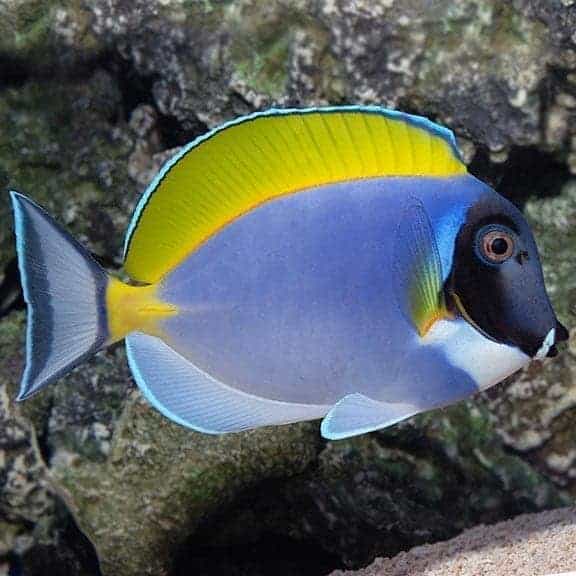The Powder Blue Tang, Acanthurus leucosternon, also known as the Powder Blue Surgeonfish, has a disk shaped body, featuring a bright light blue body with a yellow dorsal fin and caudal peduncle, and a darker face outlined in white. Making it a real eye catcher in your aquarium. The Powder Blue Tang also has a scalpel at the base of their tail fin which is very sharp and is used by the Tang for protection from predators, as well as a way of establishing itself with tank mates. Caution should be used when handling Surgeonfish as a cut from its scalpel can cause discoloration and swelling of the skin with a high risk of infection. The pain lasts for hours then still ends up having a dull ache.
The Powder Blue Tang can grow to be about 9″ and requires a tank no less than 125 gallons as a fully matured adult. A minimum 50 gallon tank will be OK temporarily for a juvenile, as they are rather slow growers, but keep in mind that too small of an environment can stunt their growth and they can develop ‘behavior issues’. Like most other Surgeonfish or Tangs, the Powder Blue Tang likes water with a moderate to heavy flow, creating currents to swim in. Being very active during the day, they require a large tank with plenty of open room to swim about while also providing plenty of live rocks and or Corals to offer some cover if frightened, and to sleep in at night. Lush natural algae growth in the tank is suggested in order for the Tang to be able to graze upon in between meals. They may also jump out of an open aquarium, so be sure to have a tightly fitting lid.
Being a peaceful fish in nature, it will get along with most other peaceful tank mates, though it will aggressively defend its territory against other Surgeonfish and Tangs, and is best kept individually. This Tang is particularly intolerant of other Tangs and should be the last fish added to your community aquarium. Unless you have a huge system, like a few hundred gallons or so, it is best to to keep only one Powder Blue Tang per system. Like all Tangs, they do not have scales to help protect them, they also do not produce as much skin mucus on their bodies as other fish, making them susceptible to diseases such as Marine Ich and Marine Velvet. Pristine water conditions should also be maintained for the overall continued health of this Tang. However, they are definitely a candidate for quarantine when you first receive them. They can be treated successfully with copper based medications, but because they have an important microfauna in their digestive system, prolonged or continuous use of a copper treatment is not advised. Keeping Neon Gobies or Cleaner Shrimp will help by providing a cleaning service for the Tang, allowing for better health overall.
It can be quite difficult to get the Powder Blue Tang to eat at first, as they can be very shy. Keeping naturally growing algae in the tank will help with this, along with blanched lettuce and brine shrimp to entice it to eat. It is also known that pellets soaked in garlic may help fend off Marine Ich, as well as entice it to eat. When you notice your Tang is more comfortable in it’s environment, you may offer a variety of algae based foods for the main part of it’s diet, along with some meaty foods. Once acclimated and it becomes accustom to aquarium foods they are quite hardy and long lived. Their diet should consist of natural algae, as well as prepared frozen formulas containing algae or spirulina. Japanese Nori or other seaweed can be offered by attaching it with a vegetable clip to a rock or the glass. Vitamin enriched frozen brine and mysis shrimp should also be offered to help with a balanced diet. Live rock with heavy algae growth is ideal, as it will allow the Tang to scrape it teeth along the rock. Feed at least 3 times daily, in smaller amounts instead of a large quantity once a day. This will help with higher water quality over a longer period of time. They will thrive in a temperature range of 75 – 79° F and a pH of 8.1-8.4.
Adjusting to a new environment can be difficult for the Powder Blue Tang, but does well once it is established. It is difficult to handle this fish and thereby is recommended only for expert aquarists.




Reviews
There are no reviews yet.